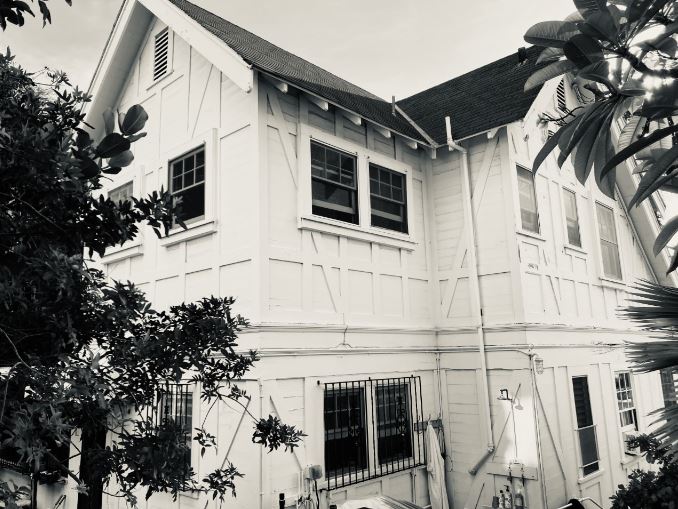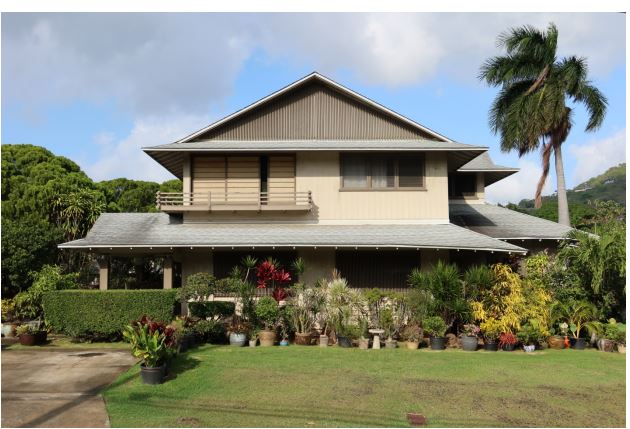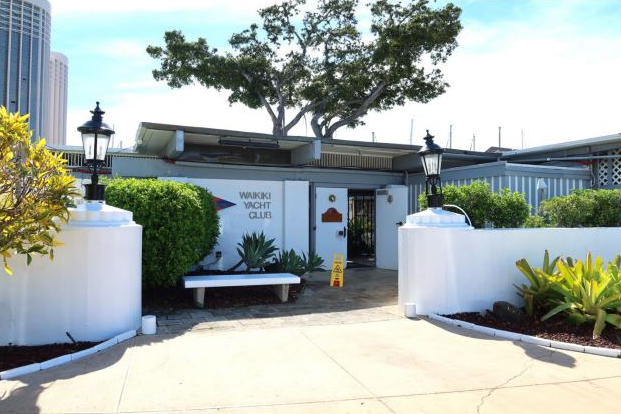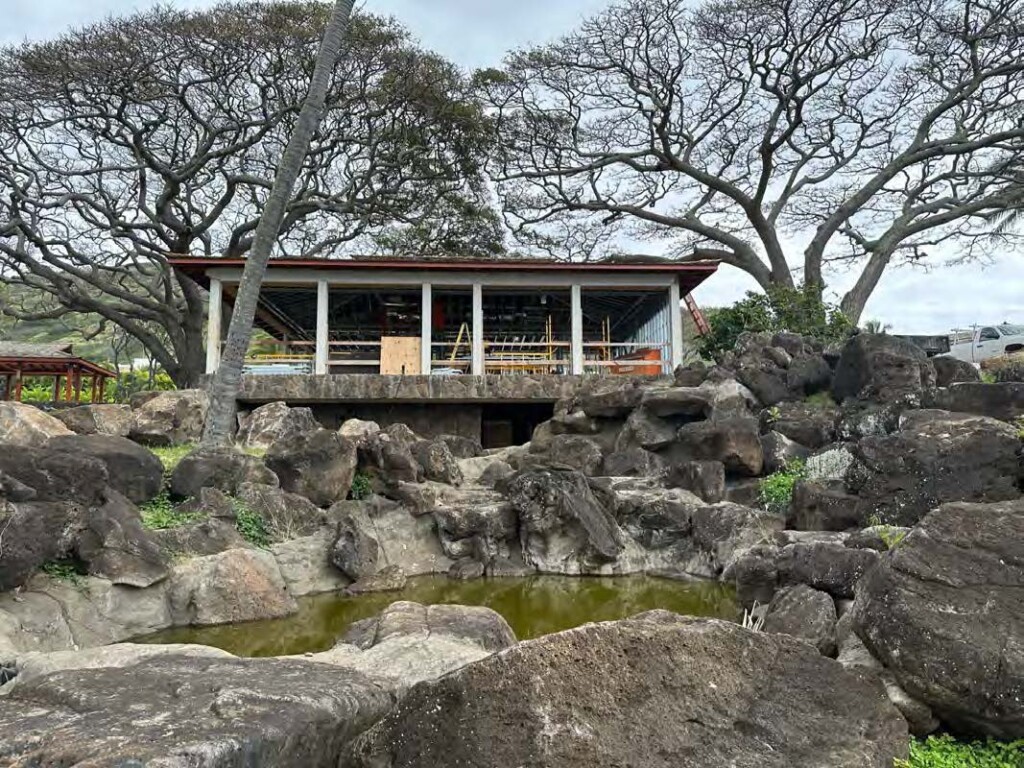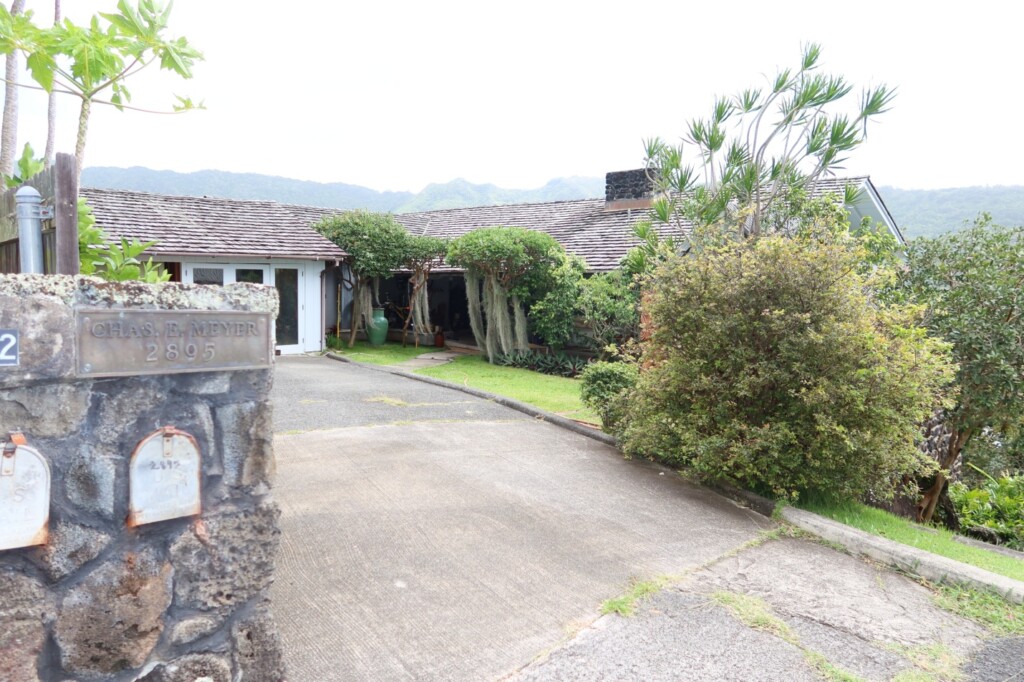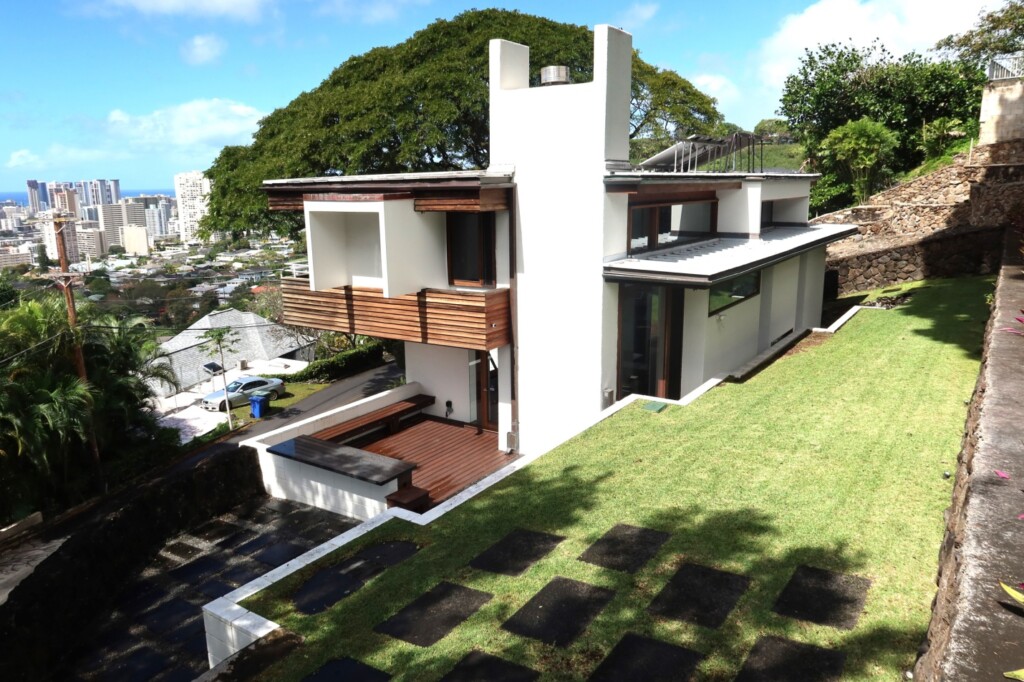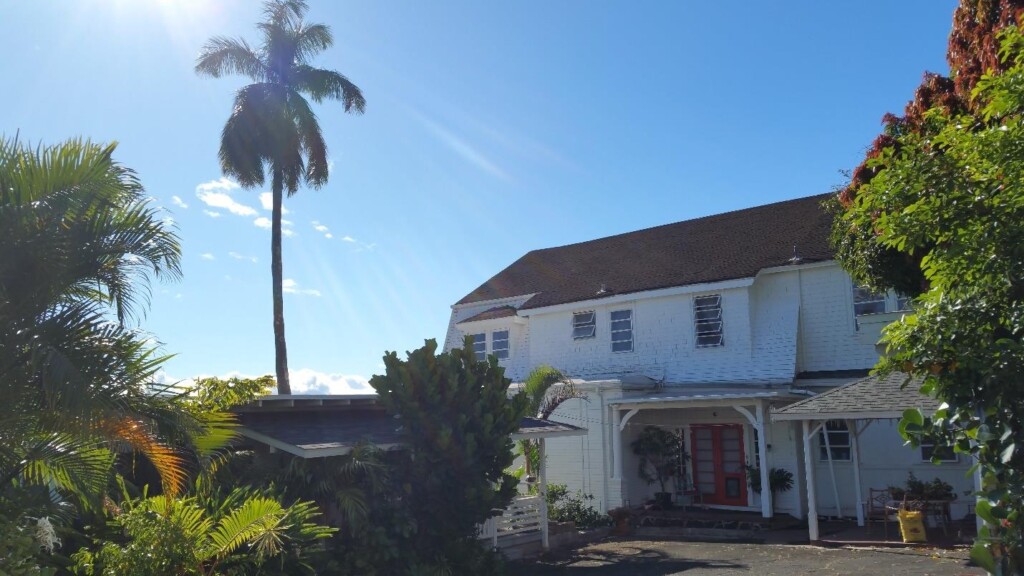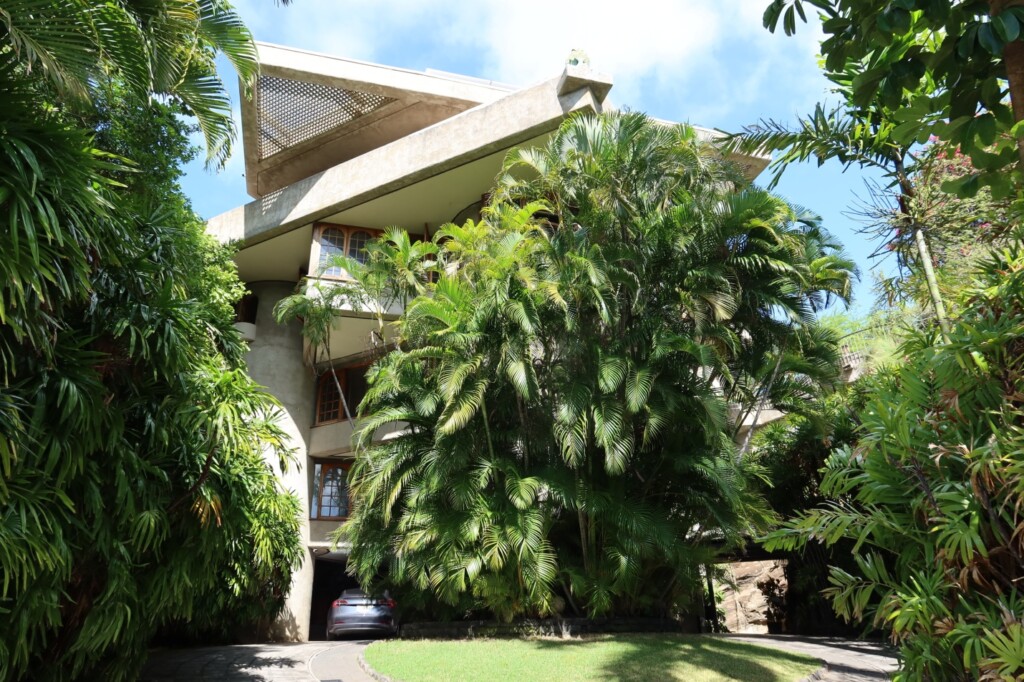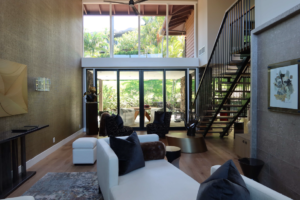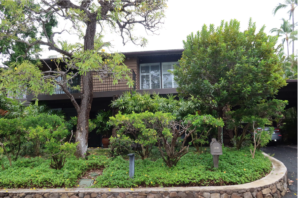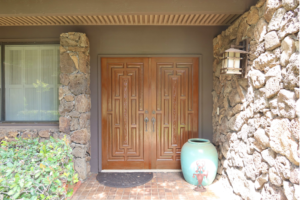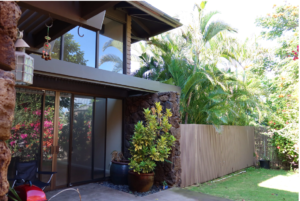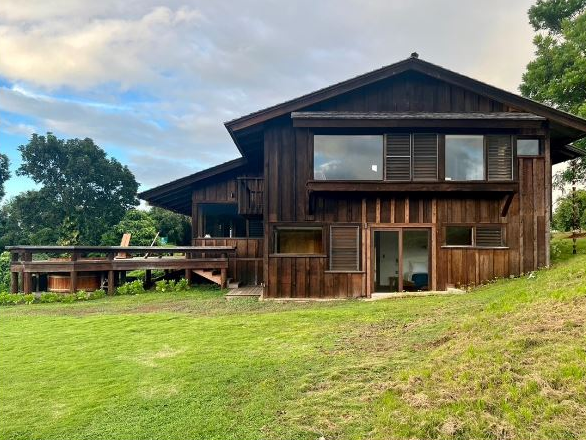The Hawai‘i Historic Places Review Board added sixteen properties to the Hawai‘i Register of Historic Places in March, May and August 2023. Learn more about their history, characteristics and significance.
Properties are eligible for inclusion in the register if they meet one or more criteria of historic significance: A) association with broad patterns or events; B) associations with historic individuals; C) architecture and design; or D) likely to yield important information.
Allison-Kang Residence, O‘ahu
The wooden, two and a half story Allison-Kang residence is was constructed in 1929. Built by Charles Ingvorsen, the house has been in the Kang family since 1951. The house is tall, asymmetrical and shaped to fit a narrow lot. It references Colonial Revival style through its asymmetrical façade, steep, high-pitched, gabled roofs, double-hung windows, and a dormer. The house is significant under Criterion A as part of an early Honolulu subdivision historically known as Diamond Head Terrace; under Criterion B as the abode of significant members of the Honolulu community; under Criterion C, for its distinctive architecture as a well-designed residence of its period. View the nomination.
Kazuo and Mary Yamane Residence, O‘ahu
The Kazuo and Mary Yamane residence is a two-story house originally constructed in 1911 for H. Stewart Johnson, the Honolulu city engineer at the time. After being purchased by Kazuo and Mary Yamane in 1958, it was heavily redesigned in 1960 by Honolulu architect Ernest Hara. The house sits on a lava rock and post and pier foundation. The wall of the façade is of raked concrete, horizontal lap siding and vertical tongue and groove, while the rear and side walls are of clapboard. Such elements as the shoji, demado and rankan, the use of vertical wood slat screens, paneled ceilings, and hip gablet roofs, all bestow a Japanese feeling. The Yamane Residence is significant on the local level under Criterion A for its associations with the development of the College Hills subdivision; under Criterion B for its associations with Kazuo Yamane; under Criterion C for its design. View the nomination.
King Residence, O‘ahu
The King Residence was designed and constructed by Alfred Preis, a Honolulu based master architect. Preis was commissioned by Mr. and Mrs. Joseph E. King in 1957 to create a modern style home that fit with the terrain and showcased spectacular vistas of Mānoa Valley. The King Residence is significant under Criterion C. The house follows an elongated rectangular plan and is rendered in a modern style with built-up, low-pitched shed-roof with an intrinsic overhanging deck supported by steel pipe trusses. It sits partially on concrete masonry retention walls and the steel trusses that are each supported by individual footings. View the nomination.
Waikīkī Yacht Club, O‘ahu
When it became obvious in the 1950’s that the Navy would not allow civilian club access to Pearl Harbor’s waters, the Waikīkī Yacht club was formed. The clubhouse was constructed in two major increments in 1953 and 1967. The Waikīkī Yacht Club is typical of the modern movement with its flat roof, clean lines and avoidance of applied ornament, as well as its emphasis on functionality and the straight forward incorporation of its structural elements into the design program. The Honolulu architectural firm of Rothwell and Lester designed the building; the contract was awarded to K. Nagata. The original CMU building consists of a large lanai and bar, with louvered doors between the bar and covered lanai. In 1967, Honolulu architect Tom Wells designed the clubhouse expansion; the current iteration of the club includes dining room, lounge area, sit-down bar, open bay to wharf, library/reading area, and pool with dressing rooms. The Waikīkī Yacht Club is significant under Criterion A for its associations with recreational boating and under Criterion C as a good example of post-World War II design. View the nomination.
Henry J. and Alyce Kaiser Estate, O‘ahu
The Henry J. and Alyce Kaiser Estate is a one-story, International Style residence following Mies van der Rohe’s architectural vocabulary having an off-centered cross-shaped plan, a flat roof design, with large glass sliding doors along the ocean front elevation. The foundation is concrete and the walls are concrete with a stucco finish or silver travertine stone veneer. The roof is flat with a thickened edge made of steel web trusses. A large covered porte cochere protrudes from the entry hallway, serving as one of the legs of the cross-shaped plan. The interior of the house reflects the International Style in the white ceilings, white floor, and white and silver travertine-clad walls. The house is located at Portlock, an early upper-class neighborhood, popular from the 1950s onward. The house fronts the ocean, and high stone/concrete walls along Portlock Road shelter the property. Built in 1959, the Henry and Alyce Kaiser Estate is locally significant under Criterion B for its close and unique association with Henry J. Kaiser, one of the America’s top business leaders and industrialists of all time.
The amended nomination enlarges the nomination boundary to include the Trophy House and Kennel Manager Quarters (1959), Water Feature (1959), and the remaining Dog Run Walls (1959), features which complement the significance of the estate as key attributes that supported its function and activities.
Carlos and Altha Panfiglio Residence, O‘ahu
The Carlos and Altha Panfiglio Residence is located on a beach front property in a residential neighborhood in Kailua. The house is significant under Criterion C as an outstanding example of prominent Honolulu architect Alfred Preis’s residential work in the early 1950s. Constructed in 1952, the home is rendered in a modern Hawaiian style typical of Preis’s work with its fine attention to detail, flowing indoor-outdoor relationships, numerous built-in pieces, and emphasis on clean, modern lines, a multiplicity of textures, and dramatic spaces. Superb design examples include the dramatically long pergola covered walkway with its distinctive tile paving, a floating ceiling transcending the living room-dining room partition wall and the natural colored fluted walls, recessed ceiling, concealed door and pergola ceiling element in the entry hall.
Charles E. Meyer Residence, O‘ahu
The Charles E. Meyer Residence built in 1951 and designed by architect Phillip Fisk, is situated in a quiet residential neighborhood in Mānoa. The Meyer Residence is significant under Criterion C for its Modern style, including the use of indirect lighting in the living rooms of the main and lower floors, the kitchen’s rectangular and square inset ceiling lights, horizontal panes in the downstairs’ living room’s door, use of extruded mortar joints in the driveway planter’s wall, and the cantilevered upper story. The house integrates many Hawai‘i-inspired elements including the lava rock fireplace, mail box post, and foundation; the lanai running across its façade; and the extensive use of double hung and sliding windows, canec ceilings and louvered doors.
W. B. “Chip” and Virginia Detweiler Residence, O‘ahu
Constructed in 1973 by architect W.B. “Chip” Detweiler as his private residence in a quiet residential neighborhood on Makiki Heights, the Detweiler Residence is an exemplary model of Tropical Modernism, emphasizing structural innovation, form and function to create a space that gracefully integrates with its setting and environment. The three-story house sits on a concrete foundation, has concrete stucco block walls and a flat roof of standing seam metal. The verticality of the white, masonry house is broken by bands of unpainted, horizontal lap siding found above the garage door, in the cantilevered third story balcony’s balustrade and the overhanging, flat roof’s fascia. The Detweiler Residence is significant under Criterion C.
George T. Kluegel Residence, O‘ahu
The George T. Kluegel Residence is significant under Criterion A for its association with the earliest development, estimated to be circa 1900, of the Pacific Heights subdivision of Honolulu, one of the first real estate development in Honolulu. The main residence is also significant under Criterion C, for the distinctive characteristics of the Dutch Colonial Revival architectural style. Notable character-defining features include the gambrel roof, dormers, neoclassical cast iron columns, and original ‘ōhi‘a wood floors. The associated bungalow, built in 194, exhibits a local vernacular architecture with its wide overhanging eaves, vertical wood plank exterior, and simplistic design, and the carport is similar with its wooden posts, low-pitch gabled roof, and lava rock rear retaining wall and is also significant under Criterion C.
Joseph and Joan Farrell Residence, O‘ahu
Construction of the Joseph and Joan Farrell Residence commenced in 1978 and was completed in 1984. The house was designed by owner Joseph Farrell who was among the preeminent architects in Hawai‘i to work in the Brutalist style. The house, integrated into the side of Diamond Head, is a bold and meticulous example of Tropical Brutalism which integrates verdant foliage, natural ventilation and a greater sense of openness into the Brutalist model known for its use of unpainted, bare concrete; angular, rigid geometric shapes and often heavy, bulky presence. The five-story house sits on poured in place, concrete cylinders, which extend from the bedrock of Diamond Head to the top story of the house. The dwelling transcends the ordinary by being built “upside down,” with its primary public living space and kitchen at the top and the more private bedroom and office spaces below. To further accentuate its uniqueness, rooms are articulated in various geometric shapes, including equilateral, isosceles and right triangles, circles, rectangles and a hexagonal lozenge, with each floor offering distinctive spatial experiences. The house exudes a high level of craftsmanship and meticulous attention to detail.
The nomination is being submitted to the National Park Service for inclusion on the National Register of Historic Places under Criterion C as an excellent example of Modern Tropical Brutalist style and Criterion G as a property that has achieved significance within the last 50 years. While nominated to the National Register, it is not yet eligible for the Hawai‘i State Register which requires properties to be 50 years or older.
La Pietra Townhouse, O‘ahu (Multiple Property Nomination)
The La Pietra Townhouse is a multiple property nomination. The townhouse was conceived in 1967 and built in 1971 by architect Louis Pursel and developer Bert Williams. The site was landscaped by San Francisco landscape architecture firm Eckbo, Dean, Austin and Williams. The site is comprised of 19 duplexes and 38 units. In 2022, 14 units were listed in the historic register; another six units were added in August 2023. The dwelling units are significant at the local level under Criterion A for their associations with the development of townhouse complexes in Hawai‘i and for their associations with historic preservation in Hawai‘i.
The 6 units added to the historic register are:
Condominium Unit 2: John Henry Felix Residence, O‘ahu
Condominium Unit 17: Russell and Jacqueline Jensen Residence, O‘ahu
Condominium Unit 18: Lawrence and Leatrice Fung Residence, Oahu
Condominium Unit 26: Chuck & Karen Mau Residence, O‘ahu
Condominium Unit 33: Patricia Mark Residence, O‘ahu
Condominium Unit 35: Louis and Betty Rodrigues Residence, O‘ahu
- Unit 2: John Henry Felix Residence
- Unit 17: Russell & Jacqueline Jensen Residence
- Unit 18: Lawrence & Leatrice Fung Residence
- Unit 26: Chuck & Karen Maui Residence
- Unit 33: Patricia Mark Residence
- Unit 35: Louis & Betty Rodrigues Residence
Carswell Residence, Kaua‘i
The Carswell Residence is located in Princeville on the North Shore of the Island of Kauaʻi, and was one of the first houses to be constructed in Princeville at the Hanalei resort community. The majority of the house’s original design features and materials are still extant: its linear massing, built into the sloped site, gable roof with open eaves, lava rock chimney, unadorned rough sawn redwood siding, and redwood windows and doors at the exterior, as well as its open floor plan, exposed wood beam ceilings, rough sawn redwood board-and-batten and plaster walls, built-in seating nooks, and lava rock chimney at the interior. Completed in 1972, the single-family house has three levels and was designed by architect Douglas Ackerman. The Carswell Residence is significant under Criterion B for its association with Donn Carswell, project manager and chief engineer of the Princeville community’s initial development in the late 1960s and early 1970s. It is also significant under Criterion C.
Hāmākua Country Club, Hawai‘i Island
Hāmākua Country Club is a nine-hole golf course with Clubhouse located on a sloping site below the circle island Māmalahoa Highway. The original layout for the golf course was designed in 1929. The property is significant under Criterion A as an example of the evolution of the integration of different ethnic groups into local social organizations and recreational facilities. The Clubhouse was built in 1956 and constructed by Honokaʻa contractor John Yamane at a cost of $15,000. A lanai addition was erected in 1957. The expansive lanai roof is supported by wood columns and ‘ōhi‘a posts. The Clubhouse is significant under Criterion C as a Modern Vernacular wood building with concrete floors, single-wall construction, one-story height, open ceiling rooms showing wood beams and the underside of totan, gable and shed roofs, and seven bays in width with a seven-pile depth. The Clubhouse’s size, 3,096 square feet, illustrates the expansion of membership over the years. Its design elements reflect an evolution from 1920s Plantation Era building designs into 1950s’ ideas that meld outdoor and interior spaces.
Mokuaikaua Church, Hawai‘i Island
Mokuaikauai Church, a large stone church centered in a small level lot near the center of Kailua-Kona, was listed on the Hawaii and National Registers of Historic Places in 1973 and 1978, respectively. Likely designed by missionary Reverend Asa Thurston, Governor Kuakini is credited with overseeing the church’s construction which was completed in 1837.
This amended nomination highlights Mokuaikaua Church’s national significance for its association with the spread of Christianity by New England missionaries to and throughout Hawai‘i and local significant as the earliest extant Christian Church in Hawaii under Criterion A. Mokuaikaua Church is also locally significant under Criterion C as a vernacular lava rock building emblematic of early churches whose design influenced ecclesiastical architecture throughout the Islands. The church itself, lava rock wall, and lava rock Memorial Arch are included as contributing to the property’s significance.


